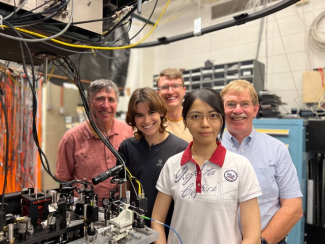JILA (a world-leading physics research institute set up by NIST and the University of Colorado Boulder) is part of a multi-university research group that will build quantum-based tools for space-based Earth sensing. NASA expects to award a $15 million grant for five years to the group of universities. This cohort includes researchers from the University of Texas at Austin, JILA, the University of Colorado Boulder (CU), the University of California Santa Barbara (USCB), the California Institute of Technology (Caltech), and the U.S. National Institute for Standards and Technology (NIST). “The award establishes the Quantum Pathways Institute, supported by a NASA STRI (Space Technology Research Institute), led by Prof. Srinivas Bettadpur of the University of Texas at Austin, Texas, with CU and UCSB as collaborating institutions,” explained Dana Anderson, a JILA Fellow and CU Boulder professor who is involved in the project. The Quantum Pathways Institute is the first of its kind, as it strives to translate the capabilities of quantum physics into usable devices called “Quantum 2.0.” Besides these developments, the Institute will offer educational training for graduate students and postdocs in quantum theory and quantum experimentation.
The project “will focus on the concept of quantum sensing, which involves observing how atoms react to small changes in their environment and using that to infer the time-variations in the Earth’s gravity field,” explained University of Texas communicator Nat Levy in a recent announcement. “This will enable scientists to improve how accurately several important climate processes can be measured, such as the sea level rise, the rate of ice melt, the changes in land water resources, and ocean heat storage changes.”
For JILA’s part, JILA Fellows Murray Holland and Dana Anderson are working with the University of Colorado researchers Penny Axelrad, Marco Nicotra, and NIST researcher Michelle Stephens. “JILA’s contribution reflects its long history in precision measurement, AMO, and quantum physics,” explained Holland. “In collaboration with the ECEE and Aerospace departments here, recent efforts have combined JILA’s quantum science expertise with modern machine learning and control methods to create high fidelity shaken optical lattice quantum sensors. Work here and elsewhere has demonstrated the potential of these methods for optimizing the design and control of quantum sensors beyond what any human has achieved to date.”
Research within the Quantum Pathways Institute will focus on developing precise quantum-based instruments specifically targeting gravity gradiometry. “Our effort builds on the well-known JILA optical lattice clock technology using ultracold atoms, but here applied to extreme inertial sensing capabilities rather than time-keeping,” Holland elaborated. Anderson added: “CU’s role is to develop the sensor including the associated hardware and systems, as well as an associated testbed, to be housed within JILA. In conjunction with the hardware is developing the optimal control and machine learning algorithms to optimize sensor characteristics.”
The shaken optical lattice gravity gradiometer will be designed to produce precise measurements critical for monitoring climate changes. “As climate shifts – with ice caps melting and sea levels and temperatures changing – that changes gravitational forces around the earth and in outer space,” Levy stated in the University of Texas announcement. “Atoms orbiting the earth respond to those gravitational changes. By measuring those reactions, the researchers can give better readings of changes in climate processes.”
The awarding of this grant will further expand JILA’s and CU Boulder’s reputations as world-leading institutes for quantum physics research. Other organizations within these systems, such as the CUbit Quantum Initiative, also help enrich this ecosystem and offer exclusive opportunities to push the frontiers of quantum physics.
Written by Kenna Hughes-Castleberry, with original source from Nat Levy at the University of Texas at Austin



 The Physics Frontiers Centers (PFC) program supports university-based centers and institutes where the collective efforts of a larger group of individuals can enable transformational advances in the most promising research areas. The program is designed to foster major breakthroughs at the intellectual frontiers of physics by providing needed resources such as combinations of talents, skills, disciplines, and/or specialized infrastructure, not usually available to individual investigators or small groups, in an environment in which the collective efforts of the larger group can be shown to be seminal to promoting significant progress in the science and the education of students. PFCs also include creative, substantive activities aimed at enhancing education, broadening participation of traditionally underrepresented groups, and outreach to the scientific community and general public.
The Physics Frontiers Centers (PFC) program supports university-based centers and institutes where the collective efforts of a larger group of individuals can enable transformational advances in the most promising research areas. The program is designed to foster major breakthroughs at the intellectual frontiers of physics by providing needed resources such as combinations of talents, skills, disciplines, and/or specialized infrastructure, not usually available to individual investigators or small groups, in an environment in which the collective efforts of the larger group can be shown to be seminal to promoting significant progress in the science and the education of students. PFCs also include creative, substantive activities aimed at enhancing education, broadening participation of traditionally underrepresented groups, and outreach to the scientific community and general public.